With the formation of the Russian- American Company in 1799, Russia began to play an important role in trade and diplomatic relations with the new American government. Unseen Treasures takes the visitor on a unique journey from the Imperial Court of St. Petersburg through the Russian winter in Siberia to the New World of Alaska and northern California and back to Moscow for the coronation of Tsar Alexander II in 1855.
St. Petersburg and the Russian Court
Beginning in the 18th century, Peter the Great began to look toward the north coast of the New World. Realizing that the region was quite close to the far end of Siberia, Peter began to plan exploration. Catherine the Great continued to encourage explorations in the 18th century but refused the petition of Siberian merchants to claim the Alaskan coast for Russia. Catherine's son and successor, Paul I, granted a charter to the trading groups that became the Russian-American Company.
His successor, Alexander I, oversaw the company's gradual development but also resisted pressures to form a colonial empire in America.
Siberia and Russian Merchants
Russian explorers and administrators traveled almost unimaginable distances across Siberia to reach the port of departure for the New World. It took Danish-born navigator Vitus Bering three years to reach the Kamchatka Peninsula at the tip of Siberia, dragging rigging, cable, and anchors across 2,000 miles of wilderness. He and his crew suffered many hardships to reach the Pacific where they built ships and began to explore the Siberian coast.
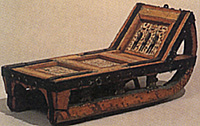 Russian sled North, 19th century Wood, iron, carving, painting.
Russian sled North, 19th century Wood, iron, carving, painting.
Siberia was a frontier peopled by Cossack farmers, a few army officers and government officials, and the merchants and other agriculturalists of this vast open space. With its harsh climate, endless winters, and the rigorous demands of daily life, Siberia was also the most suitable preparation for Alaska's rigors. Most of the traders and the few missionaries who went to Alaska were Siberians.
Voyages to the New World
In 1741, Vitus Bering commanded a two-masted ship which anchored off the Aleutian Islands while the ship's naturalist and crew members went ashore to explore. Bering died here. After many hardships, the remnant of his crew returned to their Siberian starting point.
Their stories ignited a stream of Russian hunters and traders who sailed to the New World over the next 130 years.
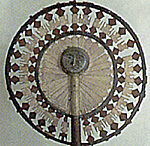 Mast of a river vessel, Russia, mid-19th century. Wood, carving,
tempera colors.
Mast of a river vessel, Russia, mid-19th century. Wood, carving,
tempera colors.
The Russian-American Company
Following Bering's voyage, small groups of adventurers visited North America. Gregory Shelikov, a wealthy Siberian merchant, founded the first permanent Russian settlement on Kodiak Island in 1784. He hired an able manager, Alexander Baranov, who extended the Russian settlements to include the important coastal site of New Archangel (Sitka).
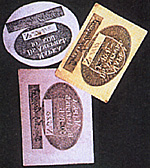 Currency, Russian-American Co. Russia, mid-19th century, Leather,
parchment, engraving.
Currency, Russian-American Co. Russia, mid-19th century, Leather,
parchment, engraving.
When Shelikov died in 1795, he left his growing mercantile enterprise in the hands of his son-in-law Nicholas Rezanov who established the Russian- American Company in 1799.
St. Innokenty, Enlightener of the Aleuts
Father John Veniaminov left Russia with his family in 1823 for the Aleutians where he lived among the people preaching the Gospel and teaching. He was an able carpenter, watchmaker, inventor, linguist, translator, ethnographer, naturalist, and sociologist. After 15 years in Russian America, he returned to St. Petersburg.
While there he learned of his wife's death and became a monk taking the name of Innokenty.
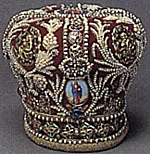 Mitre of a Bishop, Russia, early 19th century. Gold, silver, pearls,
gems, enamel, velvet, silk.
Mitre of a Bishop, Russia, early 19th century. Gold, silver, pearls,
gems, enamel, velvet, silk.
Later appointed by Nicholas I as the first Bishop of Alaska, he eventually became head of the Russian Orthodox Church in Moscow and was canonized by the Russian church in 1977.
Moscow and the Coronation of Alexander II
The opulence of 19th-century Russia is woven into the story of Alexander II, the Tsar-Liberatcor who introduced many reforms in Russia. These included emancipation of the serfs just two years before the emancipation of slaves in America. During his rule, Alexander II sold Alaska to the United States in 1867. The Russian-American Company was dissolved, but the property and territorial rights of the Russian Orthodox Church remained in Alaska.
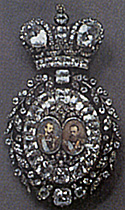 Portrait badge with Alexander II and III. Russia 1881. Gold, silver,
tempera, paste
Portrait badge with Alexander II and III. Russia 1881. Gold, silver,
tempera, paste
House of Romanov
Peter I 1682-1725
Catherine I 1725-1727
Peter II 1727-1730
Anna 1730-1740
Ivan VI 1740-1741
Elizabeth 1741-1761
Peter III 1761-1762
Catherine II 1762-1796
Paul I 1796-1801
Alexander I 1801-1825
Nicholas I 1825-1855
Alexander II 1855-1881
Alexander III 1881-1894
Nicholas II 1894-1917
Information:
The exhibit runs through April 16, 2000 at the NJ State Museum, 205 West State Stt., Trenton, NJ. Hours are Tues-Sat: 9am to 5pm, and Sundays 11am to 6pm. Closed Mondays. 609-984-5687
Review of Imperial Russia Exhibit
Back to List of Historic Sites
Back to Travel Master List
Back to MagWeb Master List of Magazines
© Copyright 2000 by Coalition Web, Inc.
This article appears in MagWeb (Magazine Web) on the Internet World Wide Web.
Other military history articles and gaming articles are available at http://www.magweb.com